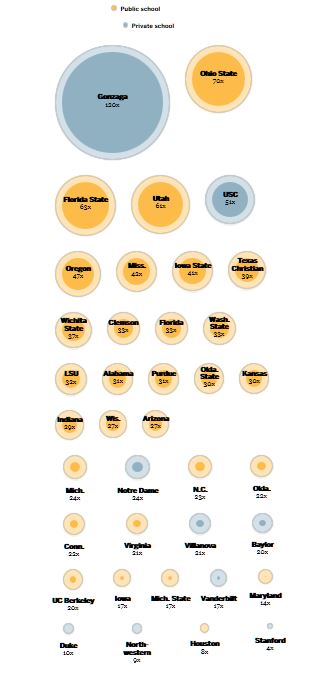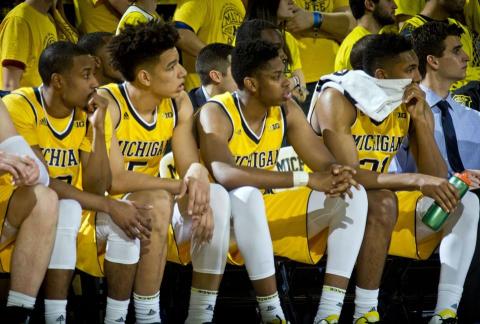Higher Education Hypocrisy and The Unhappy Marriage of Political Control and Academic Freedom
- The Height of Hypocrisy in Higher Education - Derrick Z. Jackson (The Boston Globe)
- The Unhappy Marriage of Political Control and Academic Freedom in Higher Education - Harry Targ (Diary of a Heartland Radical)
By Derrick Z. Jackson
December 13, 2015
I was only half satisfied to see how the protest of black football players at the University of Missouri helped to oust the school's racially insensitive president and chancellor. On its surface, the protest was exactly what I asked for earlier this fall at a symposium on black athletes at the University of New Hampshire: "There is much to be optimistic about if today's and tomorrow's black athletes choose to use their influence to change attitudes, chip away at disparities, and smooth the way for those in so many other crafts and professions," I said. "The challenge today is whether today's athletes, under so much pressure to conform into silence, will find a new voice. It could be as loud as Muhammad Ali's, as graceful as Tony Dungy's, or as symbolic as LeBron James's. The point is that it be heard, for the whole nation to hear."
But even as Missouri's football players met that challenge, their protest laid bare one of the greatest standing hypocrisies of higher education. Universities giant and small, public and private, bring African-American men to campus at grotesque levels to earn the school millions in football and basketball revenues. In a figurative - and nearly literal sense - at many schools, if athletes did not speak up about racism or anything else, there would be no black men at all to be heard.
In Division 1 sports nationally, an African-American male is 13 times more likely than a white male to be on football and basketball scholarship. That should be distressing enough. And yet that figure swells dramatically at schools that had a football or basketball team in the Associated Press's Top 25 rankings in mid-November - to 32 times more likely. Schools where an African-American was more than 50 times more likely to run the ball and risk brain damage, or dunk the ball and ring up the cash register for the dear ol' university were University of Southern California, Utah, Florida State, Ohio State, and Gonzaga.
Only 1 out of every 168 white men is a scholarship football or basketball player across Division 1. At Wisconsin, Stanford, and Kansas, to name a few, that ratio for black men is 1 in 7. At Vanderbilt and Duke, 1 in 5. At Oregon, Gonzaga, and Notre Dame, 1 in 4. At Villanova and Texas Christian, it is 1 in 3, and at Utah, every other black male is a scholarship football or basketball player.
Such ratios are an indictment against universities - many use black athletes up and spit them out without degrees. Even when the black athletes do graduate, colleges still send a negative underlying message that black men are only worth educating if they can also play ball. The American university thus remains one of the biggest agents in maintaining stereotypes that say ordinary black men can't think.
If colleges do not take up the challenge to look at black men as something other than athletes, the Missouri protest will forever be only a fractional victory. The black men of the nation's top collegiate football and basketball teams are too often stand-ins for the black men who ought to populate other crafts and professions.
Used
In Division 1 sports, a black male is often many times more likely to be on a football or basketball scholarship than a white male.
Click here, then hover over or tap a circle to learn more about the school

[Derrick Z. Jackson is an award-winning columnist for The Boston Globe Op-Ed section. He is a 2001 finalist for the Pulitzer Prize in commentary, a 2-time winner of opinion awards from the Education Writers Association and a 9-time winner from the National Association of Black Journalists. He also is known for his nature photography, and his images of Barack Obama have been exhibited by Boston's Museum of African American History.]
Harry Targ
December 1, 2015
And at college after college in recent years, students have rallied to block appearances by speakers whose views don't jibe with current campus orthodoxy. Most of those speakers are conservatives. (Rem Rieder, "Campuses Need First Amendment Training," USA Today-Journal and Courier, November 29, 2015, 8B).
Stories about academic freedom and free speech have been appearing in newspapers more frequently over the last few weeks. And curiously enough political actors on and off campus who traditionally have been least likely to be concerned about these subjects are becoming its major advocates.
Historically, universities, like most institutions in society, have been designed by and served the interests of the dominant powers. Higher education in the United States from the seventeenth century until the civil war educated theologians and lawyers to take leading positions in the political and economic system. As the nation was transformed by the industrial revolution, universities became training grounds and research tools for the rise of modern capitalism. Young people, to advance the needs of a modern economic system, were educated to be scientists, engineers, mathematicians, and managers. Economists were produced to develop theories that justified the essential features of capitalism.
After the rise of the United States as a world power in the 1890s, higher education increasingly included studies of international relations, weapons systems, and the particular mission of powerful nations in the world. In sum, the historical function of the American university since the 1860s has been to mobilize knowledge and trained personnel to service a modern economy and a global political power.
The conception of the university articulated by intellectuals through the centuries, however, also implied an intellectual space where ideas about scientific truths, engineering possibilities, ethical systems, the products of culture, and societal ideals would be discussed and debated. During various periods in United States history, during and after the Spanish-American War, the Progressive era, World War I and its aftermath, the Great Depression, and the Vietnam War era, for example, the university became the site for intellectual contestation. But during most periods of United States history unpopular ideas introduced in the academy by faculty or students were subject to repression, firings of faculty, and expulsion of students. This was particularly true during World War I and the depths of the Cold War.
It was out of the many forms of repression that faculty and student associations advocated for the idea of academic freedom. Articulated by philosopher John Dewey early in the twentieth century and formalized by the American Association of University Professors (AAUP), the principle, not the practice, was enshrined in official statements by both university administrators and faculty.
Despite the broadly endorsed tradition faculty were purged from universities during the 1940s and 1950s, not primarily because of their teaching and research activities, but because of alleged political associations off campus. Others were fired or did not have contracts renewed because their teaching and research challenged reigning orthodoxies about economics, politics, and war and peace. In the 1960s, universities sought to restrict the free speech rights of students as well.
For a time as a result of the tumult of the 1960s, universities began to provide more space for competing ideas, theories, approaches to education, and allowed for some discussion of fundamental societal problems including class exploitation, racism, sexism, homophobia, and long-term environmental devastation.
But by the 1990s, reaction against the expanded meaning of academic freedom set in. The National Association of Scholars was created by political conservatives to challenge the new openness in scholarship and debate on campus. Right-wing foundations funded David Horowitz to launch a systematic attack on faculty deemed "dangerous." Horowitz unsuccessfully tried to organize students to lobby state legislators to establish rules impinging on university prerogatives as to hiring of faculty and curricula. Politicians targeted scholars deemed most threatening including such noted researchers and teachers as Howard Zinn, William Ayres, Ward Churchill, and Judith Butler. The attacks of the last decade were based more on the ideas which "dangerous" professors articulated than their associations.
Since the upsurge in police violence against African Americans and terrorist attacks on Planned Parenthood, and rising Islamophobia and homophobia, a new generation of student activists has emerged challenging violence, racism, sexism, and homophobia. Students have protested against police shootings everywhere and they have linked the general increase in violence and racism to the indignities they suffer on their own campuses.
In response to the events at the University of Missouri, student activists around the country have brought demands to administrators challenging the many manifestations of racism and other indignities experienced at their schools. The response at almost all colleges and universities has not been to address the demands raised by students but instead to change the discourse from the original issues to the protection of academic freedom and free speech. In other words, university administrators and media pundits, as the quote above suggests, have swept student complaints under the rug and have used the time-honored defense of academic freedom and free speech to ignore the reality of racism, sexism, and homophobia. The defense of free speech has become a smokescreen.
Academic freedom and free speech must be defended. But it must be understood that today those who most loudly defend them are doing so to avoid addressing the critical issues around class, race, gender, homophobia, and violence that grip the nation and the world.
(For a more detailed rendition of political repression in higher education see Harry Targ, "Red Scares in Higher Education: Reinventing the Narrative of Academic Freedom," Diary of a Heartland Radical, May 21, 2015.)
[Harry Targ teaches foreign policy,US/Latin American relations, international political economy, and topics on labor studies in a Department of Political Science and a program in Peace Studies. He sees connections between theory/education and political practice. Targ is a member of the Committees of Correspondence for Democracy and Socialism (CCDS), the Northwest Central Labor Council (AFL-CIO),and the Lafayette Area Peace Coalition (LAPC). His book, Diary of a Heartland Radical, can be ordered at http://stores.lulu.com/changemaker ]
Thanks to the author for sending this to Portside.


Spread the word